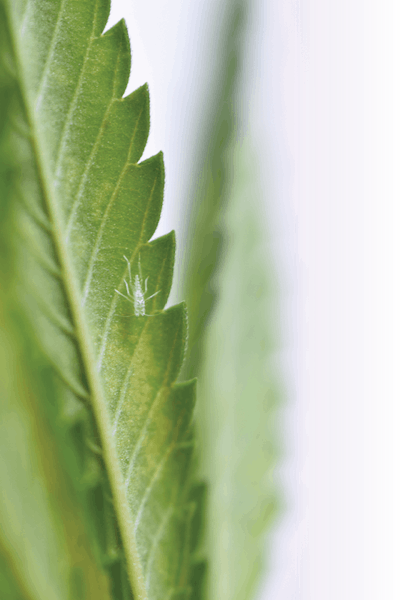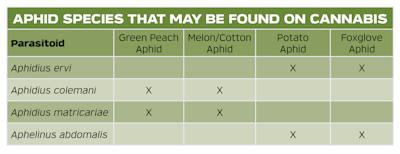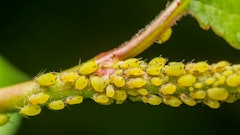
Biological control is a plant protection strategy used in different horticultural cropping systems that minimizes plant damage so that plants are marketable and/or there are no effects on yield. Biological control involves releasing parasitoids, which will regulate insect and/or mite pest populations. The primary parasitoids and predators used in controlled environments are associated with aphid parasitoids and predatory mites.
The following article is the first of a two-part series describing commercially available parasitoids and predators that can be purchased from biological control suppliers and then released to regulate insect or mite pest populations of cannabis crops. This first article will discuss parasitoids that attack aphids, and the second article will address the predatory mites that feed on fungus gnats, mites, thrips, and whiteflies.
Aphid Parasitoids
The aphid parasitoids commercially available include Aphidius ervi, Aphidius colemani,Aphidius matricariae, and Aphelinus abdominalis. Below are descriptions of each parasitoid and the aphid species found on cannabis that they attack. Table 1 (above) shows a list of the aphid parasitoids and their targeted aphid species. Although Aphidius matricariae has been shown to be effective targeting the cannabis aphid (Phorodon cannabis) specifically, more quantitative studies are needed to determine if the others are effective, although several types of aphids have been known to be found on cannabis.
Aphidius ervi
Aphidius ervi parasitizes several aphid species, including the potato (Macrosiphum euphorbiae); foxglove (Aulacorthum solani); and pea (Acyrthosiphon pisum). Adults are black, have long antennae and are 4 to 5 mm long. Development time is contingent on temperature. For example, the egg-to-adult lifecycle takes 14 days at 70°F (21°C) and 20 days at 59°F (15°C). Females use their antennae to examine an aphid host in order to assess size and determine if the aphid has already been parasitized.If not, females lay eggs into aphids by curling their abdomens under their bodies and then rapidly “poking” the aphid using an ovipositor (egg-laying device) to insert an egg. The larva will emerge (eclose) from the egg and start consuming the internal contents of the aphid. As the larva develops inside, the aphid will expand and become mummified, turning golden-yellow to brown. After five to 10 days, the larva will pupate, and a now adult parasitoid will create a hole in the back of the mummified aphid using their chewing mouthparts. The adult parasitoid will emerge, mate, and then females will start searching for new aphids to attack.
Aphidius colemani
Aphidius colemani parasitizes the green peach aphid, Myzus persicae, and the cotton/melon aphid, Aphis gossypii. Similar to A. ervi (described above) adults have long antennae, are 4 to 5 mm long, and the lifecycle varies by temperature. The optimum temperature for development and parasitism is approximately 86°F (30°C), with an egg-to-adult lifecycle of 10 to 14 days. Adults can locate low populations (fewer than 10 individual aphids) or small patches of aphid colonies on plants. The mummies or aphids parasitized by A. colemani are leathery and golden-brown.

Aphidius matricariae
Aphidius matricariae parasitizes the green peach and cannabis (Phorodon cannabis) aphid. Aphidius matricariae is similar in both size and appearance to A. colemani. Adult females can live 15 to 17 days, parasitizing more than 200 aphids, in addition to killing aphids when feeding to obtain nutrients. The optimum temperature for development is about 77°F (25°C). Aphidius matricariae does not tolerate temperatures at or above 86°F (30°C) that typically occur in greenhouses during the summer.
Aphelinus abdomalis
Aphelinus abdomalis parasitizes the potato, foxglove and other aphid species. Adults are black and yellow with short antennae, 3 mm long, and are more stout than A. ervi or A. colemani. The egg-to-adult lifecycle takes 21 days at 68°F (20°C). A female approaches an aphid and then inserts an egg using her ovipositor into the aphid while walking backwards.The resulting mummies are black. The black mummy forms in approximately seven days after an egg is inserted, and then an adult emerges from the mummified aphid after about 14 days. Aphelinus abdomalis females also will directly feed on aphids to obtain nutrients.
Before purchasing any aphid parasitoid, it is important to have the aphid species correctly identified so you can purchase and release the appropriate parasitoid species that will effectively regulate aphid populations on your crop.
Dr. Raymond Cloyd is a professor and extension specialist in horticultural entomology/plant protection in the Department of Entomology at Kansas State University. His research and extension program involves plant protection in greenhouses, nurseries, landscapes, conservatories and vegetables and fruits.








